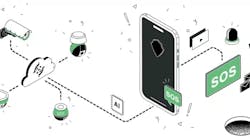Success in the perishable produce business depends upon quality. Coastal Sunbelt Produce in Savage, MD, is a leader in this industry. The largest East Coast supplier of fresh-cut fruits and vegetables, Coastal Sunbelt supplies food service customers with fresh produce every day of the year. The company’s customers include Outback Steakhouse, Applebee’s, Giant Foods, the Department of Defense, Marriott and Hyatt. A new IP video surveillance system at Coastal Sunbelt’s 165,000-square-foot distribution center and warehouse is helping the supplier increase quality control, protect against internal theft and lower costs.
More than $100,000 in Internal Theft
Coastal Sunbelt initially purchased the new surveillance system to combat internal theft in response to a costly incident of employee fraud.
“We had a manager stealing from us, coming in after hours over the period of a year and a half,” said Phil Muth, president of Coastal Sunbelt Produce. “We could see his cell phone was being used to work with a buyer of our products to sell some of our goods right out of the warehouse, about $1,500 worth of product a week. We’re selling $1,200,000 worth weekly altogether, so it’s difficult for us to monitor exact inventory levels when it’s perishable product and you naturally lose some anyway. But with these smaller amounts going out illegally over such a long time, it added up to more than $100,000!”
The waste disposal area is a classic location to monitor for internal theft. People put goods into one of the cans, roll it out to the dumpster behind the building, then drive their car around to pick it up there after hours.
Muth worked with detectives in the local police department to set up a stake-out. Cell phone records alone were not enough evidence: They had to have video and establish the long-term trend in the employee’s activities. “We had old videotapes in black and white that weren’t good and only gave us two weeks of footage at a time,” said Muth. The new surveillance system would solve this problem.
Computerized Management Systems Inc. installed Milestone XProtect Enterprise software to operate 54 sophisticated Axis and Sony cameras, which now monitor the facilities’ parking lots, fueling station, shipping/receiving bays, and indoor facilities such as administration, clean room processing and production.
“After we installed the software, I started looking at other ways to apply it to our business. Food safety came up as a big one, but the one I see developing will be the homeland security regulations,” said Muth.
Surveillance Stops Adulteration
The homeland security angle wasn’t something Muth considered when the company purchased the system, but it’s a welcome surprise. Coastal Sunbelt already has access control procedures in place, but the video system will enhance these. “In addition to the visitor passes that people use to come into the building, we utilize the IP surveillance system to monitor access to the building. This access is integrated, which gives us better control. But we’re developing other ways to use the surveillance as regulations come down from the FDA.
“During one of their many visits to our facility they asked if we are in the process of developing a homeland security approach to guard against any adulterations in transport, receiving or storage. With our IP video surveillance system from Milestone, we know we have a tool to help us manage these.”
Improving GMP and Lowering Inspection Costs
Coastal Sunbelt Produce has shown leadership in the industry by taking the processing out of the back rooms of the grocery stores and doing it in their plant in a more sanitary and controlled way. “We established an HACCP (hazardous area critical control points) plan originally developed for the food for astronauts. It makes a science out of analyzing each area where food could be contaminated by a chemical, microbiological or physical contaminate, analyzing the food’s flow through the processing system and addressing the risks of that,” Muth said.
“We’re always looking at how we can improve our HACCP plan, and the base of the plan is GMP: good manufacturing practices,” he continued. “These are things that involve your employees. Are they washing their hands after going to the bathroom; are they picking up buckets that are on the floor and then touching the food; are they putting containers on surfaces that could be contaminated and then putting them on raw product?”
When the Health Department does inspections, the number one area of company infractions is employees not following GMP. The Health Department has a grading procedure: The more often you have infractions, the more often they visit. If you’re graded Level 4, they come in once a week, and if you’re Level 1 they come in once a quarter. The inspections cost $1,000 each.
“We moved from Level 4 to Level 1, from $4,000 a month … down to $1,000 a quarter,” reported Muth. “We’ve been able to do this with the new video surveillance. The employees know that even if there’s no supervisor on the floor, the video system is on. We can see which employees have bad habits, like handling containers poorly, and show them what they’re doing wrong so they can improve. Once it’s pointed out to them, they can be trained to do better. The employees have fun with it when we play it back and it creates some peer pressure to not do these things.”
Coaching Staff with Video
The supplier uses its surveillance system to coach employees in logistics and clean room procedures as well.
“We’re able to see errors—when they happened, who did it, if a pallet goes on the wrong truck, whether they were using a system, or the system was wrong. By this, I mean a procedure where they’re supposed to put a label on the front of a pallet and stage it behind the truck, but maybe they didn’t put the label on. Again, this is when the video helps us coach people,” said Muth. “We ship about 17,000 cases each night, so if we make a mistake on one box it costs us about $33 to correct that mistake, and that can add up. Cutting down on these mistakes saves us money.”
Cameras monitor the clean room as well as the loading areas. Employees cannot take outer garments (company-supplied smocks) out of their work areas, so they must leave them in the clean room when they leave the floor. “Gloves, hairnets, things like that are all issued from the clean room and have to be turned back in to the clean room. These are all basic GMPs that the surveillance helps us to uphold,” asserted Muth.
“Letting the employees know the standards, using the surveillance as a coaching tool and not as a reprimand, really works,” he concluded. “If someone does something they’re not supposed to do, it gets brought to their attention in a manner they learn from. It has to do with their own safety, and a sense of professionalism to uphold the industry standards and deliver the best products on the market.”
Resolving Workers’ Compensation Issues
Another surprise benefit with the system is definitive management of workers’ compensation fraud.
“We had a situation previously where someone reported twisting an ankle on our steps leaving the building,” Muth said. “With the new system, the video would show what we learned from a colleague at that time: He was monkeying around playing Kung Fu with a friend when it happened! Such a liability can cost us $1,000.”
If an employee has an accident in the line of work, the company can use the video to see the complete story and defend itself where appropriate. Muth recalls an incident in which a bag fell on a man, but he didn’t make a claim because the company was able to show in the video where the employee could have avoided the accident if he had followed the proper working methods.
Remote Access for Night Activities The surveillance helps the company monitor the truck fleet night and day. The trucks fill up at the company gas tanks on the grounds, where a camera will see if they are mistakenly using the fuel meant for refrigeration purposes, which could contaminate if spilled. The trucks start loading at 10:00 or 11:00 p.m. and don’t finish until 4:00 a.m. They load 70,000 pallets nightly. This demanding schedule makes the remote monitoring capability of Milestone XProtect a great benefit for management. It allows much greater efficiency in a business that has such high daily turnover of goods.
Easy to Use
Administrative Officer Tracy Moore is the main administrator of the system. “The Milestone system is user-friendly. It only takes a few minutes to figure out how to use it,” she said. “A Computerized Management Systems engineer showed us how to log on and give the cameras names, then we were using the system right away.”
Moore likes to use the Hot Spot functionality of XProtect Enterprise to see one camera’s images in greater detail, especially when monitoring for GMPs. “The supervisors like to use the surveillance to check that the employees are using the clean room properly, washing their hands, etc. We can drill down and zoom in to really see what’s happening when they handle the produce, too, in very clear detail.”
Developing Business Intelligence
Coastal Sunbelt Produce keeps finding new ways to use the extra sets of eyes to improve their business procedures. The floor plans of the entire plant give the company a fully documented overview of the surveillance setup. “We have total control. The cameras are set up to cover every doorway and even overlap in views so there are no blind spots. They cover each warehouse aisle, all the open areas, docks, etc. If you want to follow someone from one location to another, you can, and from different angles, to catch all the details,” said Dr. Henry Tyrangiel of Computerized Management Systems. Muth and Tyrangiel agree that the IP video surveillance technology offers tremendous opportunities for continued improvements in efficiency and productivity.
Courtney Dillon Pedersen, communications manager at Milestone Systems, has handled communications for Microsoft Business Solutions and partners, Unicef and UNDP. She has worked at Esquire and Ms. Magazines as well as regional and local newspapers in New England.

